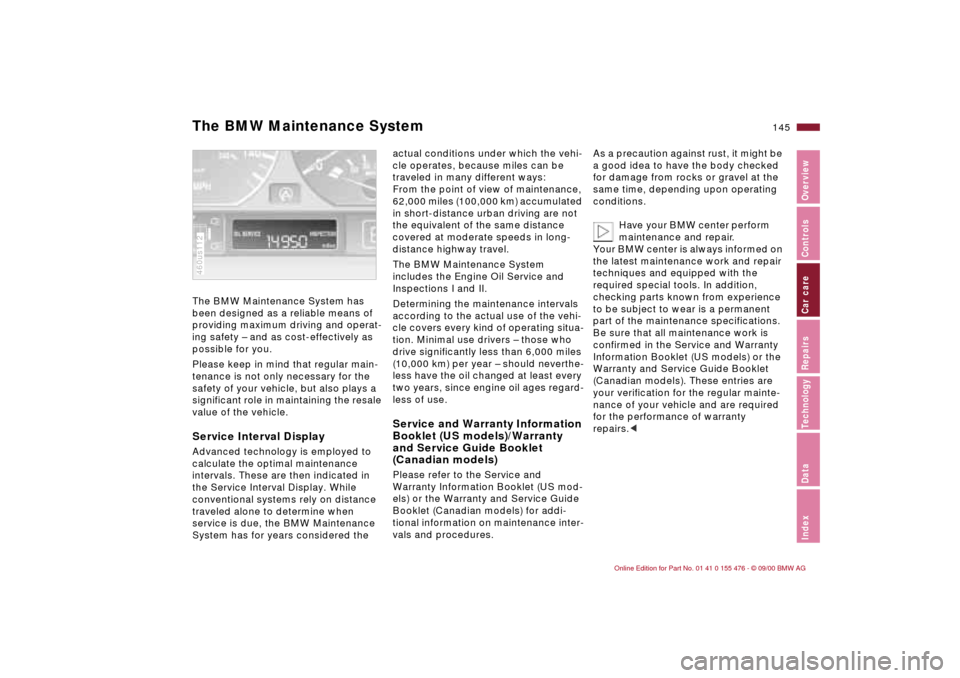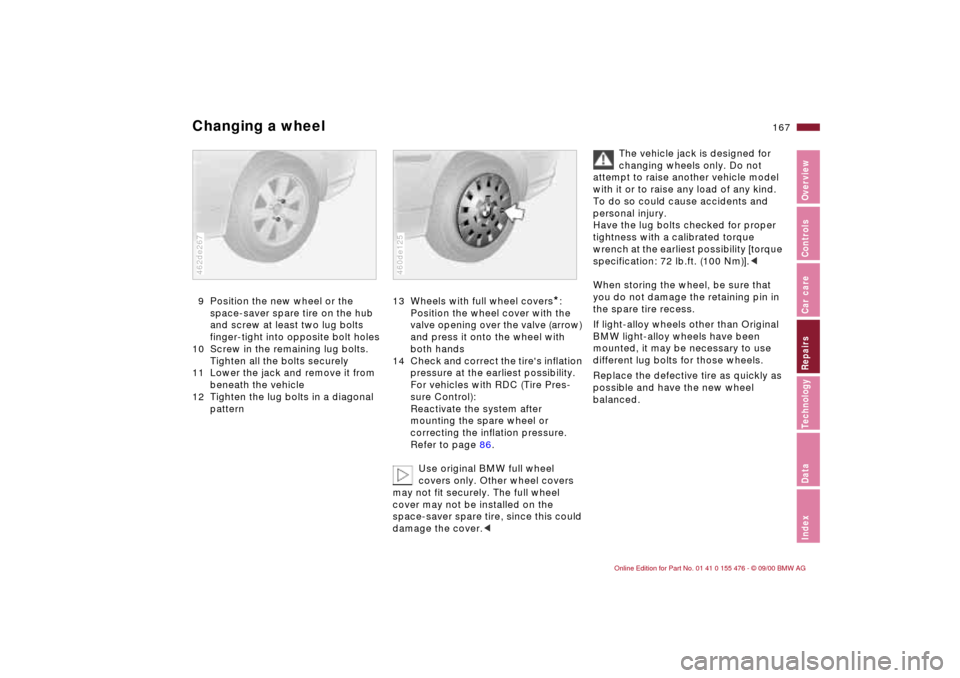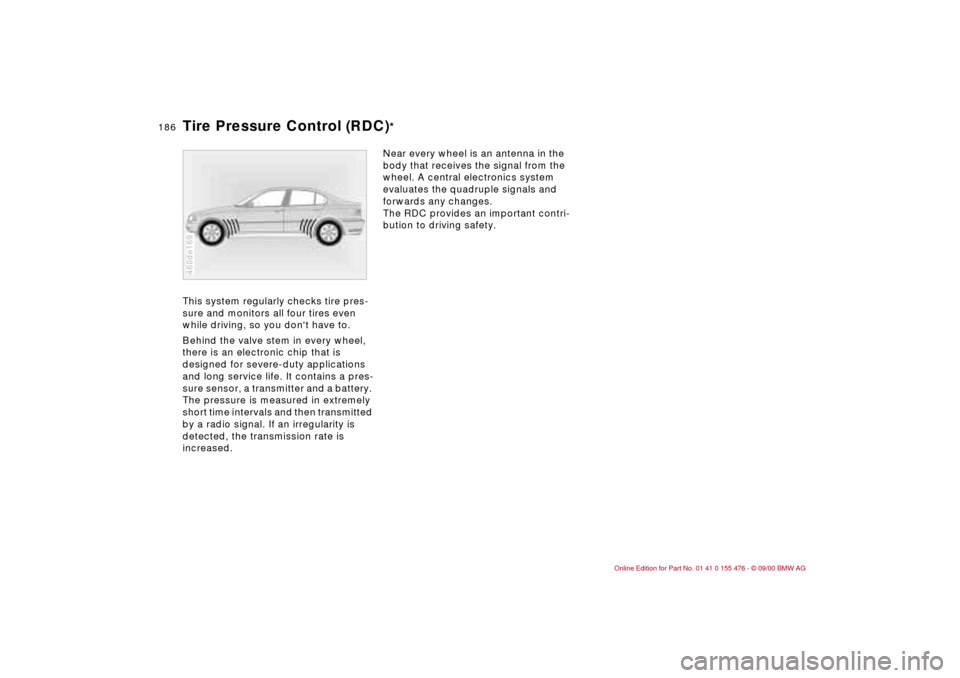2001 BMW 325i SEDAN Check control
[x] Cancel search: Check controlPage 145 of 211

145n
IndexDataTechnologyRepairsCar careControlsOverview
The BMW Maintenance System has
been designed as a reliable means of
providing maximum driving and operat-
ing safety Ð and as cost-effectively as
possible for you.
Please keep in mind that regular main-
tenance is not only necessary for the
safety of your vehicle, but also plays a
significant role in maintaining the resale
value of the vehicle. Service Interval DisplayAdvanced technology is employed to
calculate the optimal maintenance
intervals. These are then indicated in
the Service Interval Display. While
conventional systems rely on distance
traveled alone to determine when
service is due, the BMW Maintenance
System has for years considered the 460us112
actual conditions under which the vehi-
cle operates, because miles can be
traveled in many different ways:
From the point of view of maintenance,
62,000 miles (100,000 km) accumulated
in short-distance urban driving are not
the equivalent of the same distance
covered at moderate speeds in long-
distance highway travel.
The BMW Maintenance System
includes the Engine Oil Service and
Inspections I and II.
Determining the maintenance intervals
according to the actual use of the vehi-
cle covers every kind of operating situa-
tion. Minimal use drivers Ð those who
drive significantly less than 6,000 miles
(10,000 km) per year Ð should neverthe-
less have the oil changed at least every
two years, since engine oil ages regard-
less of use.Service and Warranty Information
Booklet (US models)/Warranty
and Service Guide Booklet
(Canadian models) Please refer to the Service and
Warranty Information Booklet (US mod-
els) or the Warranty and Service Guide
Booklet (Canadian models) for addi-
tional information on maintenance inter-
vals and procedures.As a precaution against rust, it might be
a good idea to have the body checked
for damage from rocks or gravel at the
same time, depending upon operating
conditions.
Have your BMW center perform
maintenance and repair.
Your BMW center is always informed on
the latest maintenance work and repair
techniques and equipped with the
required special tools. In addition,
checking parts known from experience
to be subject to wear is a permanent
part of the maintenance specifications.
Be sure that all maintenance work is
confirmed in the Service and Warranty
Information Booklet (US models) or the
Warranty and Service Guide Booklet
(Canadian models). These entries are
your verification for the regular mainte-
nance of your vehicle and are required
for the performance of warranty
repairs.<
The BMW Maintenance System
Page 154 of 211

154n
OBD interface socket The OBD interface socket for onboard
diagnostics is located on the driver's
side at the left-hand bottom of the
instrument panel and under a cover.
The cover has the letters "OBD" on it.
The purpose of the OBD system is to
assure proper emission control system
operation for the vehicle's lifetime by
monitoring emission-related compo-
nents and systems for deterioration and
malfunction.460us250
An illuminated indicator informs
you of the need for service, not
that you need to stop the
vehicle. Your system should be
checked, however, at the earliest
possible opportunity by your BMW
center.
If the indicator blinks or flashes, this
indicates a high level of engine misfire.
Reduce speed and contact your
nearest BMW center immediately.
Severe engine misfire over even a short
period of time can seriously damage
emission control components, espe-
cially the catalytic converter.
"Service Engine Soon" warning
lamp for Canadian models.
If the fuel filler cap is not on tight
enough, the OBD system can
detect leaking vapor and the indicator
will light up. If the fuel filler cap is then
tightened, the indicator will usually go
out after a short period of time.<
Page 167 of 211

167n
IndexDataTechnologyRepairsCar careControlsOverview
Changing a wheel9 Position the new wheel or the
space-saver spare tire on the hub
and screw at least two lug bolts
finger-tight into opposite bolt holes
10 Screw in the remaining lug bolts.
Tighten all the bolts securely
11 Lower the jack and remove it from
beneath the vehicle
12 Tighten the lug bolts in a diagonal
pattern462de267
13 Wheels with full wheel covers
*:
Position the wheel cover with the
valve opening over the valve (arrow)
and press it onto the wheel with
both hands
14 Check and correct the tire's inflation
pressure at the earliest possibility.
For vehicles with RDC (Tire Pres-
sure Control):
Reactivate the system after
mounting the spare wheel or
correcting the inflation pressure.
Refer to page 86.
Use original BMW full wheel
covers only. Other wheel covers
may not fit securely. The full wheel
cover may not be installed on the
space-saver spare tire, since this could
damage the cover.<
460de125
The vehicle jack is designed for
changing wheels only. Do not
attempt to raise another vehicle model
with it or to raise any load of any kind.
To do so could cause accidents and
personal injury.
Have the lug bolts checked for proper
tightness with a calibrated torque
wrench at the earliest possibility [torque
specification: 72 lb.ft. (100 Nm)].<
When storing the wheel, be sure that
you do not damage the retaining pin in
the spare tire recess.
If light-alloy wheels other than Original
BMW light-alloy wheels have been
mounted, it may be necessary to use
different lug bolts for those wheels.
Replace the defective tire as quickly as
possible and have the new wheel
balanced.
Page 186 of 211

186n
Tire Pressure Control (RDC)
*
This system regularly checks tire pres-
sure and monitors all four tires even
while driving, so you don't have to.
Behind the valve stem in every wheel,
there is an electronic chip that is
designed for severe-duty applications
and long service life. It contains a pres-
sure sensor, a transmitter and a battery.
The pressure is measured in extremely
short time intervals and then transmitted
by a radio signal. If an irregularity is
detected, the transmission rate is
increased. 460de169
Near every wheel is an antenna in the
body that receives the signal from the
wheel. A central electronics system
evaluates the quadruple signals and
forwards any changes.
The RDC provides an important contri-
bution to driving safety.
Page 187 of 211

187n
IndexDataTechnologyRepairsCar careControlsOverview
Self-diagnostics All of the important electrical and elec-
tronic systems in the vehicle are tested
regularly and automatically Ð the driver
does not have to perform any extra
operations or adjustments.
The indicator lamps also come on
briefly after the ignition has been turned
on.
While you are driving, the functional
status of the actuator motors (for the
windshield wipers, power windows,
seats, sliding/tilt sunroof, etc.) is
constantly analyzed by current
measurements in their relays.460de177
In the same manner, the electrical
resistance of the airbag ignition genera-
tors and all of the remaining airbag
components is measured at all times.
Any fault in this system would be
detected immediately by a current fluc-
tuation that would necessarily accom-
pany it. The fault would be indicated
immediately by the airbag warning
lamp.
Even after you shut off the engine, the
overall functional status of your vehicle
is monitored. For example, all of the
flaps of the heating and ventilation
system travel to the nearest limit posi-
tion. This ensures that the defrost func-
tion is always available even if a
malfunction in the air conditioner
system/automatic climate control
should occur while the vehicle is
parked overnight, for instance.
A calibration cycle runs every tenth time
the engine is shut off. During this cycle,
the actuator motors of all the heating
and ventilation flaps travel to their limit
stops in both directions. The limit posi-
tions and the return travel paths are
checked in this manner in order to
ensure that appropriate adjustments for
the operating elements can be made at
any time.You will hear the sounds of the air flaps
as the air conditioning system/auto-
matic climate control carry out their
self-diagnostic functions after the igni-
tion has been turned off. All of the other
self-diagnostics functions operate
silently in the background.
Any possible faults detected during
these self-diagnostics can be read out
by your BMW center during the next
regularly-scheduled maintenance and
corrected with a minimum of time.
Page 201 of 211

Everything from A to Z
201n
IndexDataTechnologyRepairsCar careControlsOverview
Center (high-mount) brake
lamp163
Center 3-point-safety belt in
the rear109
Center armrest105
Central locking system34
button38
Changing a tire165
Changing a wheel165
Charge indicator lamp20
Check Control76
Child restraint
systems55,59,61
Child seat59
Child seat security61
Child-safety locks55
Cigarette lighter108
Clock76
refer also to the Radio or
Onboard Monitor Owner's
Manual
Cockpit16
Coin holder105
Combination switch69
Compression192
Computer77
Configure settings53
Consumption78
Consumption display75
Contents10
Coolant122,142,195
antifreeze122 Coolant temperature
gauge75
Cooling system195
Copyright4
Cornering Brake Control
(CBC)21,119
Cruise control72
Cruising range78
Cup holder105
Curb weight194
D
Dashboard16
Data
dimensions193
engine192
weights194
Daytime-driving lamp
switch88
DBC (Dynamic Brake
Control)119
Defrost position96,101
Defroster, rear
window94,102
Defrosting the
windows96,101
Digital clock76
Dimensions193
Dipstick139
Disc brakes120
Displacement192
Displays18 Distance warning79
Diversity Antenna181
Divided rear backrest109
Door key32
Door locks, care122
Doors
child-safety locks55
emergency operation34
unlocking and locking34
Draft-free
ventilation95,102
Driving hints117
Driving in winter122
Driving lamps88
DSC (Dynamic Stability
Control)22,80,180
Dynamic Brake Control
(DBC)119
Dynamic Stability Control
(DSC)22,80,180
E
Electric power windows44
Electrical accessories,
failure170
Electrical system196
Electronic vehicle
immobilizer33
Elements of operation16
Emergency operation,
doors34
Energy Control74 Engine compartment136
Engine coolant142,195
Engine data192
Engine oil
capacity195
consumption139
pressure20
quality140
specifications140
viscosity140
Engine oil level22
check139
Engine speed192
Engine, starting62
Exterior mirrors52
F
Failure messages76
Fault displays76
Fault, ABS119
Filler cap cover27
Filling capacities195
Filling the washer
reservoir195
First-aid kit26
Fittings, towing and
tow-starting174
Flashlight104
Flat tire125,165
Fog lamps89
Folding rear backrest109
Footbrake120
Page 203 of 211

Everything from A to Z
203n
IndexDataTechnologyRepairsCar careControlsOverview
Louvers92,98
Low beam headlamps88
Low beams, bulb
replacement159
Lug bolts166
Lug wrench165
Luggage compartment41
capacity194
floor mat41
floor panel41
remote control37
Luggage compartment
lamps, bulb
replacement164
Luggage compartment
lid39
emergency release39
securing separately39
Luggage compartment
lighting39
Luggage rack113
Lumbar support49 M
M+S tires129
Maintenance75,145
Malfunction displays76
Manual transmission65
Manually controlled
recirculated-air101
Memory50 MFL (Multifunction steering
wheel)24
Microfilter95,171
Mirror memory50
Mirrors52
Mobile phone124
Modifications,
technical6,153
Motion sensor, interior42
Multifunction steering wheel
(MFL)24
N
Neckrest48 O
OBD interface socket154
Obstruction protection44
Odometer74
Oil
capacity195
consumption139
dipstick139
quality140
specifications140
viscosity140
Oil additives139
Oil change intervals, see the
Service and Warranty
Information Booklet
Oil filter change195 Oil level
check139
indicator lamp20
Oil pressure, indicator
lamp20
OILSERVICE75
Onboard tool kit158
Opening and closing Ð from
the inside38
Opening and closing Ð from
the outside34
Outside temperature
display77
Owner service
procedures206
P
Paint blemishes147
Paint, care147
Paintwork, minor
repairs148
Paintwork, waxing148
Park Distance Control
(PDC)79
Parking brake64
Parking help79
Parking lamps89
Parking, winter123
PDC (Park Distance
Control)79
Performance192
Phone, mobile124 Pocket flashlight104
Pollen95,102
Power seat49
Power steering123
Power windows44
safety switch45
Pressure monitoring,
tires86,186
Pressure, tires28,125
R
Radiator195
Radio Data System
(RDS)181
Radio reception124,181
Radio, refer to the separate
Owner's Manual
Rain sensor69,185
RDC (Tire Pressure
Control)86,186
RDS (Radio Data
System)181
Reading lamps90
Rear backrest, folding109
Rear lamps161
Rear window
defroster71,94,102
Rearview mirror52
Recirculated air mode94
Reclining seat47
Refueling27
Remote control35
Page 205 of 211

Everything from A to Z
205n
IndexDataTechnologyRepairsCar careControlsOverview
Tire inflation
pressure28,125
Tire pressure
checking28
Tire Pressure Control
(RDC)86,186
Tire pressure
monitoring86,186
Tire Quality Grading126
Tire replacement126,127
Tire rotation127
Tire specifications130
Tire tread125
To switch on the interior
lamps36
Tools158
Torque192
Tow fittings174
Tow starting174
Towing174
Track193
Traction Control System,
refer to DSC80
Transmission65
Transporting children
safely59
Tread depth, tires125
Trip odometer74
Trunk39
Trunk lid, refer to luggage
compartment lid39 Turn signal
indicator23,69,160
bulb replacement160
Turning radius193
Two-way radios124
U
Uniform Tire Quality
Grading126
Used batteries170 V
Vacuum cleaner108
Vacuum cleaner,
connecting108
Vanity mirror52
bulb replacement164
V-belts196
Vehicle battery168,196
Vehicle care
exterior147
interior150
Vehicle Identification
Number (VIN)144
Vehicle immobilizer33
Vehicle painting147
Vehicle storage152 Vehicle weight194
Ventilation92,95,98
draft-free95,102
Vinyl care149
Voice recognition24,25
W
Warning lamp "Please fasten
safety belts"21
Warning lamps20
Warning messages76
Warranty and Service Guide
Booklet145
Washer fluids138
Washer nozzles138
Washer reservoir, filling138
Washing your car146
Water on roadways
deep water117
Waxing, paintwork148
Weights194
Wheel changing165
Wheel rims128
Wheelbase193
Wheels and tires128,130
Width193
Windows, convenience
operation34
Windshield washer nozzle
adjustment138
Windshield washer reservoir,
filling138,195 Windshield washer,
automatic70
Windshield wiper69
Windshield wiper blade
replacement158
Winter operation122
Winter tires128,129
Wiper blade
replacement158
Wiper system69
Work in the engine
compartment134
X
Xenon lamps159,188